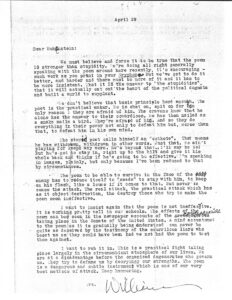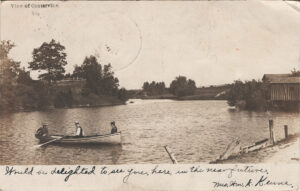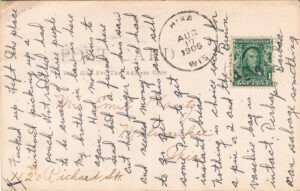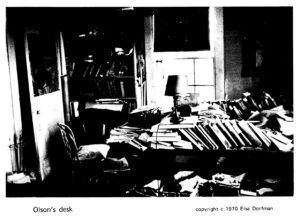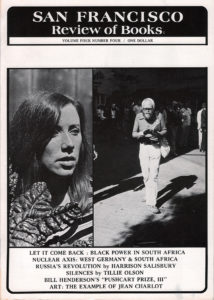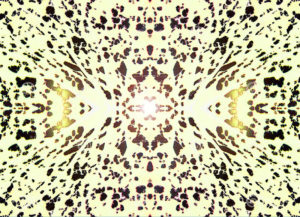Working through my archive, a copy of the above letter from William Carlos Williams, dated “April 29” and addressed to a “Rubenstein,” turned up. Given the degraded quality of the Xerox, it must have been passed around from hand to hand, and is now far removed from its origins. I have no idea how it came into my possession; my impulse was to distribute it forthwith as widely as possible, given our situation four days before a decisive political event. It does not appear in Williams’s Selected Letters, but an article from the William Carlos Williams Review (here) gives a thumbnail history. The addressee is Richard Rubenstein, editor of a little magazine The Gryphon, a poet associated with the emerging Beat movement in San Francisco who died of the effects of psychiatric treatment in 1958. The date is 29 April 1950, at which time Williams was recently investigated by the House Un-American Activities Committee (HUAC) for his association, I now believe is likely, with Popular Front groups in the Spanish Civil War but reputedly for his friendship with Ezra Pound, which resulted in his being denied appointment as the Poetry Consultant to the Library of Congress in 1949. In its resistance to the “stupidity” of “political dogma,” Williams writes: “A mind accustomed to the poem as it is gradually being understood can never be quite as deceived by the testimony of the scurrilous liars who beset us as they could have been had we not had the poem to test them against.” Four days before our opportunity to run the scurrilous liars out of power, his words have a new force. … More
>> Entries <<
October 25, 2020
Archive 08: Message @ Destination
View of Centerville.
Would be delighted to see you, here, in the near future.
Mrs. Wm. A. Keune
[Hika Wis. Aug 17 1906]
Mrs. Emil Plantz, Milwaukee, Wis.
1120 Richard Str.Fucked up. Left the place
without picking up a
pouch. Got rattled had
to be aware of three people.
My brother in law is here
again. Had more Pins to
send but a friend here
cut his finger on his saw
and needed money so I had
to go get this and sell
some Pins to get
instant bread.
Nothing is choice except for
a pin or 2 and the Brown
vaseline bag is
intact. Perhaps Barbra
can salvage something.
September 26, 2020
Entry 41: Failed Mail Art Piece
Reflective sandboxing of software code within a machine built to parse it is seen in the case of a computer language like Java which must be compiled and then run as bytecode inside a special runtime environment, or, as with the language C, compiled and then run as “native” machine instructions, or with a simple mark-up language like HTML the specifications for which must be entirely designed into any browser destined to interpret and display it, or also with other interpreted code such as a three-dimensional model whose mathematical values for vertices and textures must be transcoded according to the rules of a given data format and given style of visual projection.
—Alexander Galloway, The Interface Effect (65)
The distinction between code as executable and language as interpretable has a basic horizon in the question of new meaning. Machinic encoding is not capable of making new meaning—only humans are. But caught in the web of mediated processes (as above), humans often fail to recognize the new—or attempt to transcode it in terms of earlier structures of interpretation. The example of the “failed mail art piece” will illustrate this. … More
August 27, 2020
Archive 05: Olson in This
The first issue of This (1971) included a short photo essay and memorial to Charles Olson by photographer Elsa Dorfman, who died in May 2020. Bob Grenier, co-editor and mentor, had moved to a small house by the cove in Lanesville, Mass., on Cape Ann, and would have been in contact with Robert Creeley, Larry Eigner, and, through poetry connections, Elsa Dorfman. Olson had recently died (10 January 1970) and I was in the thick of his influence, visiting Gloucester that summer and organizing a reading group on the “modern epic” at Iowa in the academic year 1971–72 that included renowned scholar Sherman Paul, who credited the group discussion in his book Olson’s Push (1978). A signal moment in that seminar was unfolding the Coast and Geodetic Survey map of Gloucester harbor, which I bought when I visited, to provide a “spatial reading” of the otherwise cryptic poem: “In the harbor // Can 9 Nun 8 / Nun 10 Can 11 //// Charles Olson / Friday, November 23rd // #1” (Maximus IV V VI, n.p.; Maximus Poems, 302). From the map, one can track a sequence of buoys in the harbor (termed “cans” and “nuns” from their shapes, presumably) that transposes the subject-centered experience of sighting the buoys to a sequence of signs in space. It is tempting to imagine that Language writing was born right there, though there were many converging influences, never reducible to a moment of origin. In fact, it was the gap between what Olson was seeing and what his poem and the map record that signified, a way of reading that makes clear why the poem had to be written as it was. Many of the short poems from the second volume of Maximus, along with Creeley’s Pieces, were objects of fascination then. … More
May 8, 2020
Document 86: Thinking Zero Hour
The fatalism by which incom-prehensible death was sanctioned in primeval times has now passed over into utterly comprehensible life. The noonday panic fear in which nature suddenly appeared to humans as an all-encompassing power has found its counterpart in the panic which is ready to break out at any moment today: human beings expect the world, which is without issue, to be set ablaze by a universal power which they themselves are and over which they are powerless.
—Adorno and Horkheimer,
Dialectic of Enlightenment
In modernity, “Zero Hour” is an event waiting to happen, as critical theorists from Adorno to Žižek have presciently seen; our experience of the COVID-19 pandemic reconfirms the event as a “noonday panic fear” that structurally recurs. In Germany at 1945, this moment of destruction is conventionally known as Stunde Null, which we may translate as “Zero Hour.” I use the concept of Zero Hour—seen as the punctual moment of political and material destruction that ended Germany’s Totaler Krieg (total war) through unconditional surrender on 8 May 1945—as a metahistorical concept, after the work of narrative and conceptual historiographers. As such, Zero Hour is not simply reducible to its historical date; it has a structural relation to real-time historical unfolding in both narrative and nonnarrative terms. Zero Hour thus did not simply happen; rather, it is a phenomenological moment that took place “as if” it were an actual event, no matter how the particular details of history coincided with it. Psychoanalytic processes of destruction, repetition, and Nachträglichkeit are crucial for the historicity of Zero Hour, as an opening to the Real “that can only be known in its effects.” At the same time, what we term Zero Hour as a historical fact is irreducible to a concept—formed from a complex multiplicity of individual and collective, human and material experiences that only retrospectively condense into the univocal date, 8 May 1945. There is, as well, a unique political content to this historical endgame, a combination of the persistent German commitment to Totaler Krieg after massive defeats that began with Stalingrad, matched by equally persistent Allied demands for total capitulation. Zero Hour is thus a composite historical fact, viewed through an imprecise historical frame, that extends from a series of moments of destruction and liberation that constitute it. As a historical event, Zero Hour is a punctual moment that is not one, depicted and imagined through a series of iconic images of human bodies and urban destruction that took place with military defeat, the liberation of the camps, the destruction of cities, the mass displacement of peoples, occupation by allied armies, and civilian privation throughout Europe. A reduction of human experience to material bare life as a political, cultural, and even existential reference point—and its overcoming—gives Zero Hour a meaning well beyond its narrative origin as null point. My account of Zero Hour is thus not primarily concerned with the narrative it begins for the immediate postwar political or cultural order, but focuses on the moment of the event itself. Zero Hour is a material, not merely a phenomenological, event of destruction that announces a new world order; to locate it, we must work carefully through the combined figural logics and material evidence by which it was experienced and represented.
Notes and links
Text: from “Modernity @ Zero Hour: Anticipatory, Punctual, Retrospective Universals” (work in progress)
Image: Karl Hofer, Schwarzmondnacht—Potsdam, 1944
April 21, 2020
Document 85: Ashbery Lesson
Introduction
To be a writer and write things
You must have experiences you can write about.
Just living won’t do. I have a theory
About masterpieces, how to make them
At very little expense, and they’re every
Bit as good as the others. You can
Use the same materials of the dream, at last.
It’s a kind of game with no losers and only one
Winner—you. First, pain gets
Flashed back through the story and the story
Comes out backwards and woof-side up. This is
No one’s story! At least they think that
For a time and the story is architecture
Now, and then history of a diversified kind.
A vacant episode during which the bricks got
Repointed and browner. And it ends up
Nobody’s, there is nothing for any of us
Except that fretful vacillating around the central
Question that brings us closer,
For better or worse, for all this time.
—John Ashbery
Notes and links
Text: John Ashbery, “Introduction,” in A Wave (New York: Penguin, 1985): 34.
Image: Vija Celmins, Untitled (Ocean), 1977.
Links: Entry 11: “For a Left Ashbery Critique”
Entry 14: “The Perfect Ashbery (Review)”
Entry 36: “Ashbery Alpha and Omega”
April 10, 2020
Archive 03: Abjecting the Avant-Garde
Continuing my work in the archives, I want to locate the shift from a more or less happy recognition of new writing in the late 70s to what can only be called full-fledged reaction by the mid 80s. While the encounter with Duncan over a materialist reading of Zukofsky was a premonition, it was an isolated—if internalized—event. The San Francisco literary avant-gardes—Language writing among others—got a lot good press at their moment of emergence, in a climate of openness that only encouraged their work. The milieu of Left cultural activism—backed up by federal support for alternative publishing through the NEA and community arts jobs via CETA—is readable in the October 1978 cover of the San Francisco Review of Books. The author shot of Kathleen Fraser juxtaposed with Ron Silliman reading Ketjak at Powell and Market Streets goes with the Left agenda: articles on Black power, the nuclear arms race, the Russian revolution, and—the small press. As with the earlier countercultural moment in the 50s/60s, avant-garde writing and small press publishing were seen as part of a cultural politics extending out in all directions. The inky, unpretentious typography of the cover goes along with a baseline populism of multiple agendas. … More
March 23, 2020
Entry 40: Isolate Flecks
It is only in isolate flecks that
something
is given offNo one
to witness
and adjust, no one to drive the car—William Carlos Williams
21 March 2020
What I am to think about, in a room with others, is the nature of Zero Hour—our new life. Our colloquy is an opening to that question.
22 March 2020
The poet often sees oneself as an isolato, “a person who is physically or spiritually isolated from others.” We are collectively isolated, as well.
This is the common condition we have sequestered ourselves within. These are the occasions for what I am now writing: here begin.
23 March 2020
Putting on Vivaldi to get the morning started, I recognize the theme music Delta Airlines uses on its transatlantic flights, to CDG, FRA, or AMS.
Homeless panhandler on corner of southbound Lodge offramp and Forrest reaches out without direction as I round the corner, and falls over.
“With history piling up so fast, almost every day is the anniversary of something awful.” Under this rubric I find words I intend to use . . .
24 March 2020
Imagining our isolation through multiple visual maps: blue and gray dots colliding; exponential curves ticking upward; geography filling in at a rate.
The graph of deaths doubling every two days, every three or five days, every ten days—these are abstractions, what do they mean in the event?
Although concern increases with the incidence of disease, the percentage gap in belief stays constant at about 40% between red and blue states.
Am I a nonperson in a mask and hat, or the announcement of a social order to come? The learning curve for what counts as human is constant. … More
December 21, 2019
Entry 39: Ozone Holes

Pleased to learn of publication of my anti-Trump poem “Plan B” in Lana Turner, I took the magazine’s offer of a free download of Lana Turner 11 (the digital version of Lana Turner 12 is not yet out) as an anticipation of things to come. The website also links to Lana Turner 10, where I published a poem written after the 2004 election, “Blue States (After Fearing),” and indeed there is a connection to the present “Plan B,” written in November 2016. (The paywall is still up for Lana Turner 10, and readers should get the entire issue, but I will provide a .pdf of the poem here). In that poem, I tracked the psychological state I was in after the 2004 election—where George W. Bush achieved his first popular majority, thought he had a mandate, had earned capital and was going to spend it by demolishing Social Security, only to fail spectacularly to do so. At the time, my serious interest in the emergence of fascist imaginaries in American democracy began, and I would spend the next dozen years interrogating their present and past history, through my research, teaching, and travels in Germany. “Plan B” is a culmination of this effort, a poem registering the psychological state of the 2016 election through the perversion of public discourse that, in Adorno’s words from The Authoritarian Personality, indicate a “readiness” to accept anti-democratic forms of government. Adorno links these psychological preconditions of “readiness” to an ensemble of personality traits in and as “ideology”: … More
September 14, 2019
Entry 38: > Ekaterina Zakharkiv
I met Moscow poet Ekaterina Zakharkiv in St. Petersburg in November 2016, at “Other Logics of Writing: Arkady Trofimovich Dragomoshchenko at 70,” the Second International Conference on Dragomoshchenko and experimental poetics. Ekaterina was co-winner of the Dragomoshchenko Prize for younger experimental writers, presented at the new Alexandrinsky Theater on the Fontanka in St. Petersburg. Recently we began an exchange on digital poetics from our respective cultural, linguistic, and theoretical perspectives. This is a first attempt to speak of digital/media poetics across two distinct “regions of practice.”
September 12, 2019
Dear Ekaterina—
Hello! You asked about my approach to analyzing the internet poetic discourse.
I’ve cut and pasted your letter as you will see to create conditions for dialogue:
I am a graduate student of the Institute of Linguistics of the Russian Academy of Sciences, so my methodology is only starting to form, in general it may be said that the study is conducted from pragmatic-linguistic positions, in particular—the theory of speech acts, and also the linguistic poetic method.
My own basis in poetics is heavily indebted to the Formalist tradition, especially Shklovsky, Tynjanov, and Jakobson. There is a disconnect between that method—which influenced early Language writing, particularly with Hejinian, Silliman, and Harryman (and was very much in play when we had our “Letnaya Shkola” in Petersburg in 1989)—and the influences of critical theory, cultural studies, and now digital theory. I am trying to work at these intersections while being “language-centered.”
